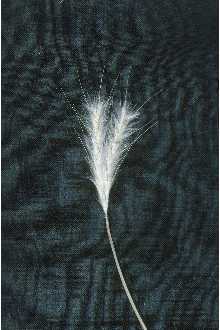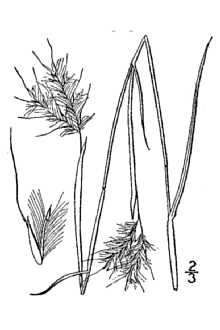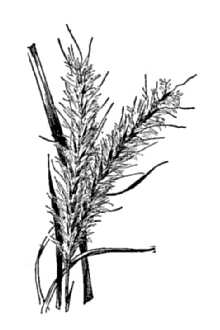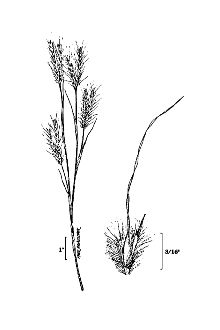Splitbeard Bluestem
Scientific Name: Andropogon ternarius Michx.

| General Information | |
|---|---|
| Usda Symbol | ANTE2 |
| Group | Monocot |
| Life Cycle | Perennial |
| Growth Habits | Graminoid |
| Native Locations | ANTE2 |
Plant Guide
Description
Split beard bluestem plant. General: Split beard bluestem is a native warm season, perennial bunchgrass. The plants usually begin growth in April and reach a mature height of 2 to 4 feet. Basal leaves are numerous, flat or rolled, ⅛ to ¼ inch wide and 10 to 16 inches long. The leaves can be glaucous, glabrous, or loosely villous. The leaf sheaths are villous and often purplish in appearance. The stems are long, slender, and erect branching in the upper 2/3 of the plant. The inflorescence is composed of paired racemes about 2 inches long, containing many sessile spikelets (.19 to .27 inch) covered in silvery white hairs (Hitchcock, 1951; Leithead et al., 1971; Tyrl et al., 2008). Distribution: Split beard bluestem is distributed from Delaware south to Florida and west to Kansas, Oklahoma and Texas. It is especially widespread in the eastern half of Texas (Diggs et al., 2006). For current distribution, please consult the Plant Profile page for this species on the PLANTS Web site (http://plants.usda.gov/) Habitat: Split beard bluestem is found on upland woodlands and woodland pastures and is commonly associated with little bluestem (Schizachyrium scoparium) on well drained sandy sites (Diggs et al., 2006 and Grelen and Hughes, 1984). Split beard bluestem raceme and spikelet (Grelen and Duvall, 1966).
Adaptation
Split beard bluestem occurs on coarse and medium, well drained, sandy and sandy loam soils with low fertility and a pH of 4.0 to 7.5. This plant is moderately shade tolerant, drought tolerant, and grows in areas with annual rainfall ranging from 20 to 60 inches (Ladybird Johnson Wildflower Center, 2016 and USDA NRCS, 2016).
Uses
Livestock: Cattle will graze split beard bluestem in the spring shortly after growth begins. The forage value is similar to little bluestem which varied from 12 to 8% crude protein from April to June, respectively on southern pine range (Leithead et al., 1971, Grelen and Hughes, 1984, and Pearson et al., 1982). Wildlife: The seeds are consumed by birds and small mammals. Native bees use splitbeard bluestem for nesting materials or utilize the plant itself as a nest structure (Ladybird Johnson Wildflower Center, 2016). Natural Resources Conservation Service Plant Guide
Ethnobotany
The Houma Indians of Louisiana used Andropogon sp. to make a decoction taken by expectant mothers to strengthen them and their child (Speck, 1941).
Status
Threatened or Endangered: No (US Fish and Wildlife Service, 2016) Wetland Indicator: Split beard bluestem is considered a facultative upland (FACU) plant in the continental United States (USDA, NRCS, 2016) Weedy or Invasive: This plant is a native species that may displace desirable vegetation in planned landscapes if not properly managed. Please consult with your local NRCS Field Office, Cooperative Extension Service office, state department of natural resources, or state agriculture department regarding its status and use. Please consult the PLANTS Web site (http://plants.usda.gov/) and your state’s Department of Natural Resources for this plant’s current status (e.g., threatened or endangered species, state noxious status, and wetland indicator values).
Planting Guidelines
Begin seedbed preparation well in advance of planting. Establish a weed free seedbed by tillage or herbicides. Prior to planting in spring, the seedbed must be firmed and have accumulated soil moisture for improved establishment success. Split beard bluestem seed is fluffy which makes it difficult to plant with a conventional grain drill. Native grass drills equipped with picker wheels or a fluffy seed box is the preferred method for planting split beard bluestem seed. When using a seed drill without picker wheels or a fluffy seed box, seed should be debearded to facilitate seed flow through the planter. Seed lubricants such as powdered graphite may also reduce bridging inside the seed box and drop tubes. Seed should be planted approximately ¼ inch deep. Planting into a fluffy or loose seedbed may cause soil to sluff off into tracks left by the planter press wheels and bury the seed too deeply after the first rain event. It is better to plant shallow than too deep. Split beard bluestem seed may also be broadcast planted but is not recommended. If seed is broadcast planted, a carrier agent such as sand or cat litter is required to help seed flow more easily through spreaders and for improved seed distribution. If possible, seed should be incorporated with a drag or cultipacker after broadcast planting. Seeding rates should be increased by 25% or more. Timing broadcast plantings to rain events will help incorporate seed into the soil and improve establishment. Spraying slurry mixtures through hydromulchers may also be more effective in certain situations such as steep slope seedings. For calibration purposes, split beard bluestem contains approximately 266,000 seeds per bulk lb. A seeding rate of 5 PLS lb/acre (30 PLS seed/ ft2) is recommended. When planting seed mixes, adjust the seeding rate according to the percent of split beard bluestem in the mixture.
Management
Contact your local NRCS field office for assistance in developing a prescribed grazing plan. Do not graze split beard bluestem during the year of planting. Cattle readily graze split beard bluestem during the spring when foliage is tender but not when it is more mature. Since split beard bluestem is not an aggressive plant, it is seldom abundant enough to significantly contribute to cattle diet and be a key management species (Grelen and Hughes, 1984). Proper grazing management of pinehill bluestem (Schizachyrium scoparium var. divergens) or little bluestem will also benefit split beard bluestem (Leithead et al., 1971). These warm season grasses are not tolerant of continuous or close grazing. To maintain stand health and production, only 50% of the current growth by weight should be harvested during a growing season. To control weeds, mow to a 8-10 inch stubble height or apply labelled herbicides for weed control. Split beard bluestem tolerates
Pests and Potential Problems
Possible pests of split beard bluestem include aphids, leaf spot, spider mites, spittlebugs, and rust (Hoffman Nursery, 2016).
Environmental Concerns
Concerns
Concerns
Split beard bluestem produces light, fluffy seeds that are wind distributed. Split beard bluestem is a native grass species and its escape from planted areas would not be considered hazardous or detrimental to the natural landscape.
Control
Split beard bluestem may be controlled by mechanical means such as mowing or by applying a broad spectrum herbicide labelled for control of grasses. Please contact your local agricultural extension specialist or county weed specialist to learn what works best in your area and how to use it safely. Always read label and safety instructions for each control method.
Seeds and Plant Production
Plant Production
Plant Production
Use soil test to determine fertility and pH levels and adjust deficiencies according to soil test recommendations, Split beard bluestem will be most productive in fields receiving full sun to moderate shade (Leithead et al,, 1971), Seed production fields can be started by transplants or direct seeding, Transplanting is the quickest establishment method, reduces the time needed to achieve a solid stand, and allows for use of pre-emergent herbicides, Seed may be harvested in the first year, Direct seed splitbeard bluestem in the spring with a native grass drill, For direct seeding procedures, see Planting Guidelines, Split beard bluestem is indeterminate and begins to flower in late August, Seed matures from October to December and can be harvested using a flail harvester or combine, The flail harvester is a nondestructive harvest method allowing multiple harvests of seed production fields, This machine harvests mature seed, leaving the immature seed for a later harvest, When harvesting with a combine, use low volume air settings to minimize seed loss, After harvest, the seed should be dried and debearded to partially remove awns and other seed appendages before cleaning, Use soil moisture sensors to measure the soil moisture of Splitbeard Bluestem., A seed cleaner with air adjustments and separation screens is used to remove stems, chaff, and unfilled seed, To enhance seed longevity, store seed in a humidity and temperature controlled environment, Cultivars, Improved, and Selected Materials (and area of origin) Split beard bluestem ecotypes are commercially available, Purchase split beard bluestem seed based on local climate, resistance to local pests, and intended use, Consult with your local land grant university, local extension or local USDA NRCS office for recommendations on adapted materials for use in your area, Neches Germplasm split beard bluestem is a composite release adapted to Major Land Resource Areas 133B and 87A in USDA Harvesting fluffy seed of split beard bluestem with a flail harvester, Split beard bluestem seeds, Plant Hardiness Zones 8a and 8b of the Western Coastal Plain, Neches Germplasm is recommended for use in seed mixtures for establishment of conservation cover and wildlife habitat plantings in native pine (Pinus sp,) stands,
Literature Cited
Diggs, G., B. Lipscomb, M. Reed, and R. O’Kennon. 2006. Illustrated flora of east Texas vol. 1. Center for Environmental Studies and Dept. of Biology, Austin College, Sherman, TX and Botanical Research Institute of Texas, Ft. Worth, TX. Grelen, H. and V. Duvall. 1966. Common plants of longleaf pine-bluestem range. Res. Paper SO-23. USDA-USFS Southern Forest Experiment Station. New Orleans, LA. 4 Grelen, H. and R. Hughes. 1984. Common herbaceous plants of southern forest range. Res. Paper SO-210. USDA-USFS Southern Forest Experiment Station. New Orleans, LA. Hitchcock, A. 1951. Manual of the grasses of the United States. 2nd ed. Rev. by A. Chase. USDA Misc. Pub. 200. Washington, DC. Hoffman Nursery. Andropogon ternarius (Splitbeard broomsedge). Accessed online 6/30/16 at http://hoffmannursery.com/plants/details/andropogon-ternarius. Ladybird Johnson Wildflower Center. Andropogon ternarius (Splitbeard bluestem). Accessed online 7/1/16 at http://www.wildflower.org/plants/result.php?id_plant=ANTE2. Leithead, H., L. Yarlett, and T. Shiflet. 1971. 100 native forage grasses in 11 southern states. Agr. Handbook No. 389. USDA-SCS. Washington, DC. Pearson, H., H. Grelen, E. Epps, M. Johnson and B. Blakewood. 1982. Botanical composition and nutritive value of cattle diets on southern pine range. Res. Paper SO-178. USDA-USFS Southern Forest Experiment Station. New Orleans, LA. Speck, F. 1941. A list of plant curatives obtained from the Houma Indians of Louisiana. Primitive Man 14:49-75. Tyrl, R., T. Bidwell, R. Masters, and R. Elmore. 2008. Field guide to Oklahoma plants commonly encountered prairie, shrubland, and forest species. Oklahoma State Univ. Stillwater, OK. US Fish and Wildlife Service. 2016. Environmental conservation online system species report. Dept. of the Interior-US Fish and Wildlife Service. Washington, DC. USDA, NRCS. 2016. The PLANTS Database. National Plant Data Team, Greensboro, NC 27401-4901 USA. Varner, J., J. Kush, and R. Meldahl. 2003. Vegetation of frequently burned old-growth longleaf pine (Pinus palustris Mill.) savannas on chocolocco mountain, Alabama, USA. Natural Areas Journal 23:45-52. Citation Brakie, M. 2016. Plant Guide for splitbeard bluestem (Andropogon ternarius Michx.) USDA-Natural Resources Conservation Service, East Texas Plant Materials Center. Nacogdoches, 75964. Published: September 2019 Edited: jld For more information about this and other plants, please contact your local NRCS field office or Conservation District at http://www.nrcs.usda.gov/ and visit the PLANTS Web site at http://plants.usda.gov/ or the Plant Materials Program Web site: http://plant-materials.nrcs.usda.gov. PLANTS is not responsible for the content or availability of other Web sites. The U.S. Department of Agriculture (USDA) prohibits discrimination against its customers, employees, and applicants for employment on the bases of race, color, national origin, age, disability, sex, gender identity, religion, reprisal, and where applicable, political beliefs, marital status, familial or parental status, sexual orientation, or all or part of an individual's income is derived from any public assistance program, or protected genetic information in employment or in any program or activity conducted or funded by the Department. (Not all prohibited bases will apply to all programs and/or employment activities.) If you wish to file an employment complaint, you must contact your agency's EEO Counselor (PDF) within 45 days of the date of the alleged discriminatory act, event, or in the case of a personnel action. Additional information can be found online at http://www.ascr.usda.gov/complaint_filing_file.html. If you wish to file a Civil Rights program complaint of discrimination, complete the USDA Program Discrimination Complaint Form (PDF), found online at http://www.ascr.usda.gov/complaint_filing_cust.html, or at any USDA office, or call (866) 632- 9992 to request the form. You may also write a letter containing all of the information requested in the form. Send your
Plant Traits
Growth Requirements
| Temperature, Minimum (°F) | -18 |
|---|---|
| Adapted to Coarse Textured Soils | Yes |
| Adapted to Fine Textured Soils | No |
| Adapted to Medium Textured Soils | Yes |
| Anaerobic Tolerance | None |
| CaCO3 Tolerance | Medium |
| Cold Stratification Required | No |
| Drought Tolerance | High |
| Fertility Requirement | Low |
| Fire Tolerance | Medium |
| Frost Free Days, Minimum | 140 |
| Hedge Tolerance | None |
| Moisture Use | Low |
| pH, Maximum | 7.5 |
| pH, Minimum | 4.0 |
| Planting Density per Acre, Maxim | 11000 |
| Planting Density per Acre, Minim | 3400 |
| Precipitation, Maximum | 60 |
| Precipitation, Minimum | 20 |
| Root Depth, Minimum (inches) | 10 |
| Salinity Tolerance | None |
| Shade Tolerance | Tolerant |
Morphology/Physiology
| After Harvest Regrowth Rate | Slow |
|---|---|
| Toxicity | None |
| Resprout Ability | No |
| Shape and Orientation | Erect |
| Active Growth Period | Summer |
| Bloat | None |
| Coppice Potential | No |
| Fall Conspicuous | No |
| Fire Resistant | No |
| Flower Color | Green |
| Flower Conspicuous | No |
| Foliage Color | Green |
| Foliage Porosity Summer | Moderate |
| Foliage Porosity Winter | Porous |
| Fruit/Seed Color | Yellow |
| Nitrogen Fixation | None |
| Low Growing Grass | No |
| Lifespan | Moderate |
| Leaf Retention | No |
| Known Allelopath | No |
| Height, Mature (feet) | 3.9 |
| Growth Rate | Moderate |
| Growth Form | Bunch |
| Fruit/Seed Conspicuous | No |
| Foliage Texture | Fine |
Reproduction
| Vegetative Spread Rate | None |
|---|---|
| Small Grain | No |
| Seedling Vigor | Medium |
| Seed Spread Rate | Slow |
| Seed per Pound | 216000 |
| Fruit/Seed Persistence | No |
| Propagated by Tubers | No |
| Propagated by Sprigs | No |
| Propagated by Sod | No |
| Propagated by Seed | Yes |
| Propagated by Corm | No |
| Propagated by Container | No |
| Propagated by Bulb | No |
| Propagated by Bare Root | Yes |
| Fruit/Seed Period End | Fall |
| Fruit/Seed Period Begin | Summer |
| Fruit/Seed Abundance | Medium |
| Commercial Availability | No Known Source |
| Bloom Period | Late Summer |
| Propagated by Cuttings | No |
Suitability/Use
| Veneer Product | No |
|---|---|
| Pulpwood Product | No |
| Protein Potential | Low |
| Post Product | No |
| Palatable Human | No |
| Palatable Graze Animal | High |
| Palatable Browse Animal | High |
| Nursery Stock Product | No |
| Naval Store Product | No |
| Lumber Product | No |
| Fodder Product | No |
| Christmas Tree Product | No |
| Berry/Nut/Seed Product | No |



